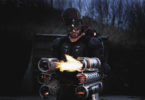More than a decade ago, before I was the children’s author, strongman competitor, amateur MMA competitor and streetwise Hercules I am now, I was pretty good at juggling. I could do fire torches, which are quite easy, and Mill’s Mess, which is a bit harder, and a five-ball cascade, which is the sort of thing that might get you a bit of grudging respect from other jugglers, if you hang out with them. I could even eat an apple while juggling it, which is actually something you can learn in one day of juggling but all non-jugglers seem to think is some sort of impossible feat. But I digress.
Among jugglers, you’ll often hear the phrase ‘a drop is a sign of progress.’ In other words, failure is sort of inevitable, and by failing more often, you’re getting the bad stuff out of the way so you can get to the good stuff. This mindset isn’t unique to juggling. In jiu-jitsu, well-known black belt Keith Owens says you should ‘tap 10,000 times’ on the path to your black belt. One of the most respected books on drawing and a foundation of art courses worldwide, Kimon Nikolaides’ The Natural Way To Draw, says that ‘The sooner you make your first 5,000 mistakes, the sooner you can correct them.’ But is that true?
I don’t think so. My favourite juggling author was always Charley Dancey, an irreverent chap from my former stomping ground of Bath who wrote The Encyclopaedia Of Ball Juggling. Charley doesn’t believe that a drop is a sign of progress. Charlie’s credo?
‘A drop is a sign that you have made a mistake.’
Here’s what I think. Mistakes are inevitable in most fields: but the most important thing is to avoid repeating them. You could drop a juggling ball a hundred times, and if you’re still doing the same thing wrong, you haven’t learned anything. You can keep getting tapped out with the same chokehold, and it doesn’t mean you’re getting any better. You can keep drawing hands wrong, and if you never address the fundamentals of why, you aren’t ever going to draw them right.
There are lots of ways to stop making mistakes. In juggling, you can analyse your own performance – because, after all, if you’re not dropping the balls and what you’re doing looks good, then you’re doing it right. In jiu-jitsu things are more complex – you could be ‘winning’ rounds but still getting things wrong that would cost you against a more experienced opponent, so the best option is to find someone high-level and get them to tell you what the problem is. In drawing, I’m not sure what you do – I’m terrible at drawing – but a firm grasp of fundamentals seems like a good place to start.
There’s nothing wrong with making mistakes. But mistakes alone are not a sign of progress.
HOMEWORK: In whatever field you’re interested in, get someone higher-level than you to take a quick look at what you’re doing and suggest one thing that would make it better. You probably already know how to do this – it could be submitting a form-check video to a weightlifting forum, asking your coach why you never seem to land a jab, or asking someone why you can’t draw hands properly. Get it done, and stop making one mistake forever.





Leave a Comment